上海交通大学:《操作系统 Operating System》课程教学资源(课件讲稿)OS-Process Synchronization_Lec13
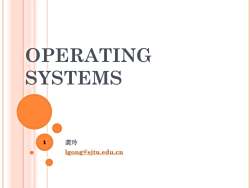
OPERATING SYSTEMS 1 龚玲 lgong@sjtu.edu.cn
OPERATING SYSTEMS 龚玲 lgong@sjtu.edu.cn 1
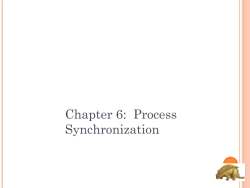
Chapter 6:Process Synchronization
Chapter 6: Process Synchronization

REVIEW o Background o The Critical-Section Problem o Peterson's Solution o synchronization Hardware o http://wenku.baidu.com/course/study/77fldcccda38376ba flfae94#665ea0c7aa00b52acfc7ca94
REVIEW Background The Critical-Section Problem Peterson’s Solution Synchronization Hardware http://wenku.baidu.com/course/study/77f1dcccda38376ba f1fae94#665ea0c7aa00b52acfc7ca94
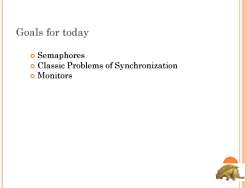
Goals for today o Semaphores o Classic Problems of Synchronization o Monitors
Goals for today Semaphores Classic Problems of Synchronization Monitors
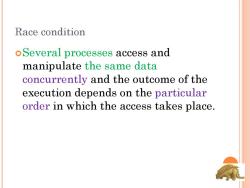
Race condition oSeveral processes access and manipulate the same data concurrently and the outcome of the execution depends on the particular order in which the access takes place
Race condition Several processes access and manipulate the same data concurrently and the outcome of the execution depends on the particular order in which the access takes place
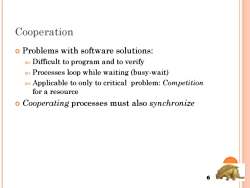
Cooperation o Problems with software solutions: Difficult to program and to verify Processes loop while waiting(busy-wait) Applicable to only to critical problem:Competition for a resource o Cooperating processes must also synchronize 6
Cooperation Problems with software solutions: Difficult to program and to verify Processes loop while waiting (busy-wait) Applicable to only to critical problem: Competition for a resource Cooperating processes must also synchronize 6
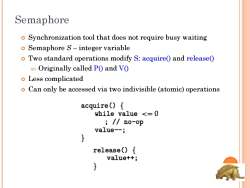
Semaphore o Synchronization tool that does not require busy waiting o Semaphore S-integer variable o Two standard operations modify S:acquire0 and release( Originally called PO and VO o Less complicated o Can only be accessed via two indivisible(atomic)operations acquire(){ while value <=0 ;/no-op value--; release(){ value++;
Semaphore Synchronization tool that does not require busy waiting Semaphore S – integer variable Two standard operations modify S: acquire() and release() Originally called P() and V() Less complicated Can only be accessed via two indivisible (atomic) operations
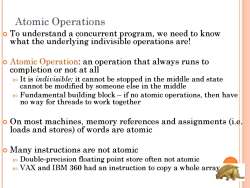
Atomic Operations o To understand a concurrent program,we need to know what the underlying indivisible operations are! o Atomic Operation:an operation that always runs to completion or not at all It is indivisible:it cannot be stopped in the middle and state cannot be modified by someone else in the middle Fundamental building block-if no atomic operations,then have no way for threads to work together On most machines,memory references and assignments (i.e. loads and stores)of words are atomic o Many instructions are not atomic Double-precision floating point store often not atomic VAX and IBM 360 had an instruction to copy a whole array
Atomic Operations To understand a concurrent program, we need to know what the underlying indivisible operations are! Atomic Operation: an operation that always runs to completion or not at all It is indivisible: it cannot be stopped in the middle and state cannot be modified by someone else in the middle Fundamental building block – if no atomic operations, then have no way for threads to work together On most machines, memory references and assignments (i.e. loads and stores) of words are atomic Many instructions are not atomic Double-precision floating point store often not atomic VAX and IBM 360 had an instruction to copy a whole array

Semaphore as General Synchronization Tool o Counting semaphore-integer value can range over an unrestricted domain o Binary semaphore-integer value can range only between 0 and 1;can be simpler to implement Also known as mutex locks Semaphore S=new Semaphore(); S.acquire(); /critical section S.release(); /∥remainder section
Semaphore as General Synchronization Tool Counting semaphore – integer value can range over an unrestricted domain Binary semaphore – integer value can range only between 0 and 1; can be simpler to implement Also known as mutex locks
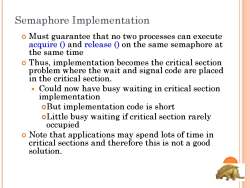
Semaphore Implementation o Must guarantee that no two processes can execute acquire and release on the same semaphore at the same time o Thus,implementation becomes the critical section problem where the wait and signal code are placed in the critical section. Could now have busy waiting in critical section implementation oBut implementation code is short oLittle busy waiting if critical section rarely occupied Note that applications may spend lots of time in critical sections and therefore this is not a good solution
Semaphore Implementation Must guarantee that no two processes can execute acquire () and release () on the same semaphore at the same time Thus, implementation becomes the critical section problem where the wait and signal code are placed in the critical section. Could now have busy waiting in critical section implementation But implementation code is short Little busy waiting if critical section rarely occupied Note that applications may spend lots of time in critical sections and therefore this is not a good solution
按次数下载不扣除下载券;
注册用户24小时内重复下载只扣除一次;
顺序:VIP每日次数-->可用次数-->下载券;
- 上海交通大学:《操作系统 Operating System》课程教学资源(课件讲稿)OS-Process Synchronization_Lec12.pdf
- 上海交通大学:《操作系统 Operating System》课程教学资源(课件讲稿)OS-Lec24_Review.pdf
- 上海交通大学:《操作系统 Operating System》课程教学资源(课件讲稿)OS-Lec24_DISK MANAGEMENT AND I/O.pdf
- 上海交通大学:《操作系统 Operating System》课程教学资源(课件讲稿)OS-Lec23_file system implementation.pdf
- 上海交通大学:《操作系统 Operating System》课程教学资源(课件讲稿)OS-Lec22_file system implementation.pdf
- 上海交通大学:《操作系统 Operating System》课程教学资源(课件讲稿)OS-Lec21_file system interface.pdf
- 上海交通大学:《操作系统 Operating System》课程教学资源(课件讲稿)OS-Lec20_virtual memory.pdf
- 上海交通大学:《操作系统 Operating System》课程教学资源(课件讲稿)OS-Lec19_virtual memory.pdf
- 上海交通大学:《操作系统 Operating System》课程教学资源(课件讲稿)OS-Lec18_mainmemory.pdf
- 上海交通大学:《操作系统 Operating System》课程教学资源(课件讲稿)OS-Lec17_mainmemory.pdf
- 上海交通大学:《操作系统 Operating System》课程教学资源(课件讲稿)OS-Lec16_mainmemory.pdf
- 上海交通大学:《操作系统 Operating System》课程教学资源(课件讲稿)OS-Introduction_Lec3.pdf
- 上海交通大学:《操作系统 Operating System》课程教学资源(课件讲稿)OS-Introduction_Lec2.pdf
- 上海交通大学:《操作系统 Operating System》课程教学资源(课件讲稿)OS-Introduction_Lec1.pdf
- 上海交通大学:《操作系统 Operating System》课程教学资源(课件讲稿)OS-deadlock_Lec15.pdf
- 上海交通大学:《操作系统 Operating System》课程教学资源(课件讲稿)OS-cpuscheduling_Lec11.pdf
- 上海交通大学:《操作系统 Operating System》课程教学资源(课件讲稿)OS-cpuscheduling_Lec10.pdf
- 上海交通大学:《C++程序设计与实践》课程教学资源(课件讲稿)第2讲 C++语言的基本数据类型与表达式.pdf
- 上海交通大学:《C++程序设计与实践》课程教学资源(课件讲稿)第1讲 绪论.pdf
- 上海交通大学:《面向对象软件工程 Software Engineering》课程教学资源《面向对象软件工程实践指南》教材资料(WORD版).docx
- 上海交通大学:《操作系统 Operating System》课程教学资源(课件讲稿)OS-Process Synchronization_Lec14.pdf
- 上海交通大学:《操作系统 Operating System》课程教学资源(课件讲稿)OS-process_Lec4.pdf
- 上海交通大学:《操作系统 Operating System》课程教学资源(课件讲稿)OS-process_Lec5.pdf
- 上海交通大学:《操作系统 Operating System》课程教学资源(课件讲稿)OS-process_Lec6.pdf
- 上海交通大学:《操作系统 Operating System》课程教学资源(课件讲稿)OS-process_Lec7.pdf
- 上海交通大学:《操作系统 Operating System》课程教学资源(课件讲稿)OS-process_Lec8.pdf
- 上海交通大学:《操作系统 Operating System》课程教学资源(课件讲稿)OS-semaphore EXERCISES.pdf
- 上海交通大学:《操作系统 Operating System》课程教学资源(课件讲稿)OS-OPERATING SYSTEMS(LINUX SYSTEM CALLS).pdf
- 上海交通大学:《操作系统 Operating System》课程教学资源(课件讲稿)OS-thread.pdf
- 上海交通大学:《操作系统 Operating System》课程教学资料(Java)Java Introduction.docx
- 上海交通大学:《操作系统 Operating System》课程教学资料(JAVA PPT)lec1.ppt
- 上海交通大学:《操作系统 Operating System》课程教学资料(JAVA PPT)lec2.ppt
- 上海交通大学:《操作系统 Operating System》课程教学资料(JAVA PPT)lec3.ppt
- 上海交通大学:《操作系统 Operating System》课程教学资料(JAVA PPT)lec4.ppt
- 上海交通大学:《操作系统 Operating System》课程教学资料(JAVA PPT)lec5.ppt
- 上海交通大学:《操作系统 Operating System》课程教学资料(Java)Java Primer.pdf
- 上海交通大学:《操作系统 Operating System》课程教学资料(Java)Java多线程应用实例(制作烟花效果).doc
- 上海交通大学:《操作系统 Operating System》课程教学资料(Java)Java多线程编程.pdf
- 上海交通大学:《操作系统 Operating System》课程教学资料(Java)JAVA多线程编程详解(详细操作例子).doc
- 上海交通大学:《操作系统 Operating System》课程教学资料(Java)Java学习笔记(JAVA的面向对象编程——课堂笔记).doc
